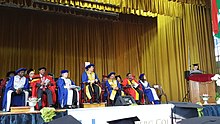Helderberg College of Higher Education
[6] The history of Seventh-day Adventist education in South Africa began in 1893 with the establishment of Claremont Union College, Cape Town.
College subjects included Greek and Latin, Trigonometry and Geometry, Chemistry and Physics, Logic and Moral Science.
Besides the classical academic education, emphasis was placed on character development, a vocational programme, laws of health, physical training and culture.
[citation needed] Over the 25 years of its existence, two distinct education points of view have waxed and waned with regard to curriculum.
Despite academic polemics and financial problems compounded by the Anglo-Boer War, the College filled a vital role in providing a religious atmosphere with values that rang true for the 50-100 young people who studied there each year.
[citation needed] The site for Claremont Union College had been chosen because of the strong conviction that a secluded, rural location was most conducive to true education, but by 1917 sprawling urban growth posed a threat.
After looking at 50 farms in the Western Cape, the committee unanimously chose Bakkerskloof with its flourishing almond and apricot orchards flanking Helderberg mountain.
As it was first called, the new African Missionary College opened in 1928 with two dormitories completed and plans for the construction of the administration building well underway.
The academic growth of the College can be viewed from three perspectives: the course offerings, educational qualifications of the staff, and library holdings.
The 1955 graduating class was the first to wear full academic regalia, including colours to represent the various fields of study.
Agriculture offered as a two-year Associate of Science degree met a specific demand for a few years but was later phased out.
The escalating cost of post-graduate study overseas precipitated plans to offer such degrees at Helderberg College.
In 1981, under the leadership of Dr. D. Birkenstock, the Andrews University affiliation was extended when the MA in Religion degree was first offered on campus.
Strand and Heppenstall, many lecturers from overseas made a real contribution to the ministerial force in Southern Africa.
The post-graduate degree gave impetus to the rapid expansion of the library, and in 1983 the E. G. White Research Centre and Heritage Room were officially opened by Mrs. Hedwig Jemison.
[9] In 1997, under the leadership of David F. Allen, an additional affiliation agreement was entered into with Southern Adventist University (located in Collegedale, Tennessee, USA).
This affiliation provided alternative accreditation and academic recognition for the BBA degree, majoring in either accounting or management.
101 of 1997), private institutions of higher learning were granted the opportunity of becoming fully accredited and registered providers of education, issuing their own degrees and diplomas.
Students transferring to other tertiary institutions or wishing to engage in postgraduate study in South Africa can do with ease, as there is a common registering body with controlled standards and criteria.
Some of the first lecturers to earn a doctorate at a South African University included Dr. Hofni Joubert (in the late fifties), Dr. Izak J. van Zyl (in the seventies), with Dr. Delyse Steyn being the first woman to achieve this.
Since it is a Seventh-day Adventist College, a major objective is to "make religion a personal experience in the life of each student, a practical religion which finds expression in the standards of conduct, in the attitudes and ideals, and in the development of a sense of individual responsibility for the betterment of mankind" (Principal M. P. Robison, College Clarion, 1932).
From the establishment of the Missionary Volunteer Society in the early days of Claremont Union College to the present, students have gained valuable experience in leadership as they have organised and run their own outreach activities to those in the community.
These find their counterparts today in the form of soup kitchens in the squatter camps, outreach to Boys' Town and visiting the sick and elderly in hospitals and old age homes.
The harmonious development of all the student's abilities, including his or her physical well-being, has been the basis for the work programme in the history of Helderberg College.
Claremont Union College had as their main activities sewing, cooking, carpentry, gardening, janitorial services, dairy farming, boot making, typesetting and printing (forerunner of the Southern Publishing Association), and assisting with health treatments.
A nut butter factory was started to provide a non-dairy spread which was in harmony with the health principles of the College.
Of the various enterprises launched through the years, the farm is the only one that has maintained operations to the present time and continues to provide the College with an income through olive groves, fruit and vegetables, and pine forestry.
In the early days, the students worked as brick makers, builders and carpenters to erect the various college buildings and homes.
The new campus needed student workers to lay out gardens, trim hedges, and care for the appearance of the College.
Many alumni have attributed their success in part to the effective time management, interpersonal skills and respect for productive work that they had learned while in college.





